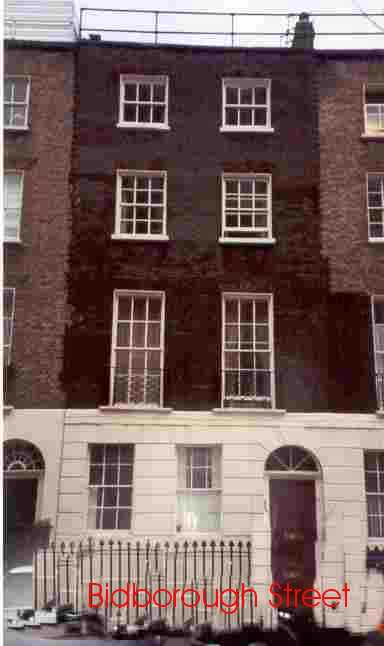Here, in the beginning of 1850, at 24a Bidborough Street, was born William Strong Darby, junior--(The house itself has gone, but there are several similar houses from the period still standing there, and in the nearby streets, most built by Decimus Burton, so named for having been his father's tenth son)-- The new William was taken back to Waltham Abbey, to show to the family, and to be baptised at the venerable Abbey Church, in a 'batch' with some country cousins, as the register shows. The register shows something else, too, that has perhaps remained unspoken for a century and a half : turning
 back the
pages we find that six months or so before their wedding, Elizabeth had given birth to a
baby girl, Elizabeth Strong Holden. There can be little doubt William was the father. One
can only speculate on the significance of the choice of Strong rather than Darby for her
middle name.The child died four months later --'Debility from Birth.'
back the
pages we find that six months or so before their wedding, Elizabeth had given birth to a
baby girl, Elizabeth Strong Holden. There can be little doubt William was the father. One
can only speculate on the significance of the choice of Strong rather than Darby for her
middle name.The child died four months later --'Debility from Birth.'William Strong Darby junior, however, was more robust. He needed to be : in the previous year nearly half a million people had contracted cholera; in the September alone there had been 7,000 deaths as the disease ravaged the poor quarters of London. But with the beginning of the new decade came a new mood. Whether or not he was taken to the great Crystal Palace Exhibition of 1851 we do not know, but it is difficult to imagine them not taking one of the hundreds of special horse-buses for the trip to Hyde Park, on one of the Exhibition's regular 'cheap days', when the world and his wife were flocking there from much further afield.
And then, in 1852, when little William was nearly three, and now living round the corner from Bidborough Street, in Sandwich Street, where the family had moved into new lodgings at number18, a brother, Arthur Darby, was born. The arrival was marked by firework displays all over London, as it was to be for the rest of his life --(he was born on November 5th). And as it also coincided with the extravagant state funeral of the 'Iron' Duke of Wellington, 'Arthur' was virtually inevitable as a choice of name --(the Duke's name was Arthur Wellesley). Suddenly the nation's cots were full of little swaddled Arthurs, and its city squares full of new stone 'Arthurs' - as Dickens complained, one could scarcely walk round a street corner in the dark without bumping into a freshly sprung statue of Arthur, Duke of Wellington.
The weather was terrible all that month --at one point the gun-carriage bringing the Duke's body into London was nearly swept into the Thames. And once again, the tailoring trade was soon depressed following the usual flurry of business supplying dress for the obligatory period of official national mourning.
But then in 1853 came that perennial answer to economic slumps : a good old, very profitable for some, utterly pointless war, fought in someone else's country. William senior said that he worked in Bond Street during the Crimean war, and there is no reason to doubt it. There was a tremendous demand for tailors of all sorts to supply thousands of military uniforms in very short order. The not always very qualified 'slop' and 'dung' workers were 'sweated', providing for the other ranks -( Despite much corruption and exploitation they met the deadlines, too, but the War Office managed to 'overlook' actually delivering them, and thousands of British troops faced their first Crimean winter without even their great coats!) - However, the officer class, who needed a full wardrobe for travelling abroad, could not be served by any less than fully time-served craftsmen. Journeymen tailors with William's background and experience were at a premium among the 'quality' trade centred on Bond Street. It was even a chance to 'put by a few bob', while it lasted.
Certainly they were now living in that vicinity, at 20 Adam Street, (Where the present Seymour Place meets Oxford Street). And there, while the war dragged on, ten weeks after the Charge of the Light Brigade, in January 1855, was born William and Elizabeth's 'first' -(as far as their posterity knew)- daughter, Angelina Darby, whom we might not unreasonably suppose to have been named after the earlier Angelina Darby, Maryanne's 'base-born' daughter in Stortford. Sadly, we know very little about this new Angelina, except what she looked like, from a photograph taken in her late teens or early twenties, and that William junior's and Arthur's children called her 'Aunt Annie'.
In 1856, after the loss of over a quarter of a million men on both sides, and nothing discernible gained beyond financiers' profits, the war finished. And along with it, the boom time for tailors. The traditional trade was also coming under pressure from the new cut-price, 'ready-to-wear', merchants -- 'A flash jacket, dazzler wescitt, shocking loud kicksies (trousers), with left and right trotter boxes (boots) thrown in, all for 15/-' --such as the brothers Moses -(later to become Moss Bros.)-- and there were even rumours of bulk cutting machines somewhere in Yorkshire. Not to mention those dreadful, clumsy, american 'sewing-machine thingies'. The chances of even a highly experienced journeyman ever setting up as a small master, once a reasonable expectation, must have seemed remote indeed.